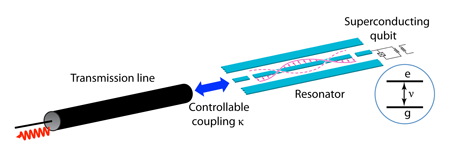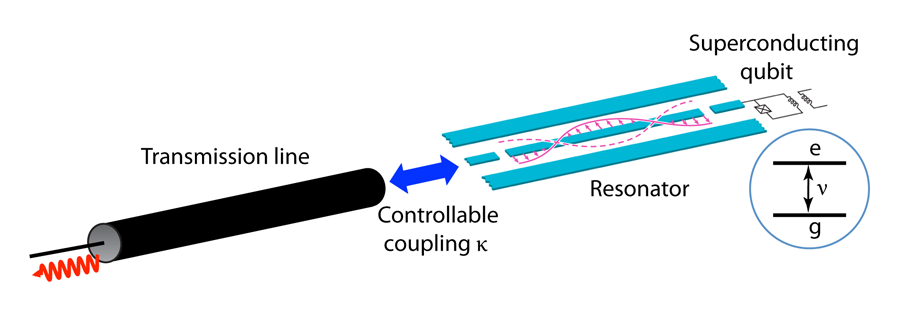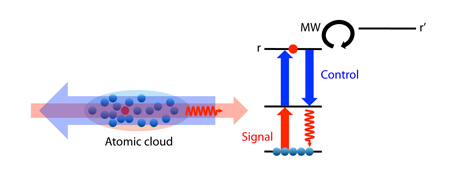Catch and Release of Photons
Information and communication technologies continue to revolutionize our modern societies. Further transformation may come from quantum technologies, which are still in their infancy but offer the possibility to process information more efficiently or to communicate more securely than any conceivable classical technology could. People are already dreaming of a quantum internet [1] that would connect the places where quantum bits of information are stored with the centers where qubits are processed. In between these sites, the information would be carried by photons, which are often called “flying qubits.” We are not there yet, but many groups around the world are exploring various ways to interface photons with devices able to store or process quantum information.
Two new papers in Physical Review Letters present original and complementary developments in the pursuit of a practical matter-photon quantum interface [2,3]. At first sight the two systems look very different. However, a closer look reveals many similarities that will be detailed below. But before doing that, let us sketch out the criteria that a quantum interface should fulfill [4]. First, you want a medium that can absorb photons as efficiently as possible, so that information is not lost. Second, you want these photons to be stored in the medium for durations as long as possible. And third, you want to be able to release the photons on demand. These criteria are enough for an electronic memory device that might be part of an optical fiber network, but in order to make a quantum interface, you are going to need to store the quantum information of the photons in the degrees of freedom of the medium. The fragile nature of this quantum information complicates the entire enterprise.
Many strategies exist for trying to capture the quantum information of a photon. Examples of possible interfaces include ions in rare-earth crystals, laser-cooled atoms or ions, and hot vapors [4]. The two works described here present original systems that are only starting to be studied but are full of promise.
In the first case, Yi Yin from the University of California, Santa Barbara, and colleagues use an artificial atom trapped in a cavity to catch and release microwave photons [see Fig. 1]. The artificial atom is a superconducting circuit based on Josephson junctions and characterized by two energy levels separated by a transition of around 7 gigahertz. This two-level system serves as a qubit that couples to microwaves [5]. The researchers can tune the qubit transition frequency by varying a magnetic flux through the circuit so that the circuit is resonant with the cavity, which is a centimeter-long microwave resonator. The cavity is itself coupled to a transmission line, which can send “flying qubits” (microwave photons) to other devices.
The breakthrough that this paper achieves is to provide a controllable coupling κ between the cavity and the transmission line—this is equivalent to having a switch on the output mirror of the cavity that turns its reflectance on and off. In a typical experimental run, Yin et al. excite the qubit, which is resonant with the cavity. This results in one photon being deposited in the cavity mode. At the start, the “output mirror” is reflective ( κ=0), so the photon is stored in the cavity until the mirror is turned off, at which point the photon is released into the transmission line. The device can also receive photons. The researchers show that they can send a wave packet of about ten photons through the transmission line and into the cavity where it is stored. They can also send a quantum superposition of “one photon” and “no photon,” and the cavity will store this nonclassical state as a superposition of the two levels in the superconducting circuit.
Daniel Maxwell and his colleagues from Durham University in the UK operate a very different system. In their case, the photons are in the optical domain (with wavelength of 780 nanometers), and they can propagate in free space or be guided in an optical fiber over long distances. The system they use to store light is a small cloud containing about 100 cold atoms [see Fig. 2]. To demonstrate the interface, they use three atomic states in a ladder configuration coupled by an infrared laser (called the signal laser) and a blue laser (the control laser). The upper state is a Rydberg state—a state with a very large dipole moment and a very long lifetime compared to other atomic excitations. The large dipole moment has a strong effect on nearby atoms. If one atom in the cloud is excited into the Rydberg state, it shifts the resonance frequencies of all the surrounding atoms so that they are no longer in resonance with the control laser. This process, called Rydberg blockade, has potential application in quantum processing tasks [6]. Here, it serves as a storage mechanism.
Maxwell et al. begin by shining the control beam on the atom cloud. They then turn on a very weak signal pulse (ultimately it can contain only one photon) that excites only one out of all the atoms because of the Rydberg blockade. The cloud is dense enough that the signal pulse is efficiently absorbed (stored) when propagating through the cloud. The tricky point here is that we don’t know which atom is excited, so the cloud is in a collective quantum state, called a polariton [7], which is a superposition of all states with just one excited atom and the rest of the atoms in the ground state. At the end of the storage time, the team releases a photon by turning on the control beam alone: this triggers the deexcitation of the one Rydberg atom to the intermediate state, from which it emits a single photon at the same frequency as the signal beam. Importantly, the released photon has the same direction as the control laser because of constructive interference. In this system, the long-lived Rydberg state acts like a cavity to store the light. Likewise, the control beam, which effectively “opens the cavity” to release a photon, is equivalent to the mirror with controllable transmission in the case of Yin et al.
For both devices the storage time of the photons is limited to only a few microseconds due to losses, but both research groups have identified the loss mechanisms and thus should be able to increase the storing duration in the future. But, quite importantly, they have also demonstrated some quantum manipulations over the systems that make them good candidates for a practical quantum interface. For example, Yin et al. showed that they can catch and release a wave pulse without disturbing its phase. They have also demonstrated that this phase is preserved even if the quantum state of the photons is nonclassical. For their part, Maxwell et al. showed quantum control over the polariton by using microwave light to couple the Rydberg state to another Rydberg state. This control is impressive, as it implies the coupling of the whole fragile superposition of the atoms in the cloud to a new polariton with a different Rydberg state, which is not coupled to the controlled laser. With their demonstrated level of control, both groups have the ability to shape the emitted photon wave packet, and also to prepare an arbitrary nonclassical state of the light.
The progress displayed here is significant, but the performance of these interfaces still needs to be improved. For example, the ability to capture light is only around 10%, which is a bit low for practical implementation. Currently, both methods can capture a pulse of incoming light, but more work will be needed to catch a single photon, which is the desired sensitivity for a quantum processor or quantum memory. The interesting parallels between these two different quantum interfaces suggest that we are converging on an eventual solution.
References
- H. J. Kimble, “The Quantum Internet,” Nature 453, 1023 (2008)
- Y. Yin et al., “Catch and Release of Microwave Photon States,” Phys. Rev. Lett. 110, 107001 (2013)
- D. Maxwell, D. J. Szwer, D. Paredes-Barato, H. Busche, J. D. Pritchard, A. Gauguet, K. J. Weatherill, M. P. A. Jones, and C. S. Adams, “Storage and Control of Optical Photons Using Rydberg Polaritons,” Phys. Rev. Lett. 110, 103001 (2013)
- C. Simon et al., “Quantum Memories. A Review Based on the European Integrated Project Qubit Applications (QAP),” Eur. J. Phys. D 58, 1 (2010)
- B. Goss Levi, “Superconducting Qubit Systems Come of Age,” Phys. Today 62, No. 7, 14 (2009)
- M. Saffman, T. G Walker, and K. Moelmer, “Quantum Information with Rydberg Atoms,” Rev. Mod. Phys. 82, 2313 (2010)
- M. Fleischauer, A. Imamoglu, and J. P. Marangos, “Electromagnetic Induced Transparency: Optics in Coherent Media,” Rev. Mod. Phys. 77, 2003 (2005)







